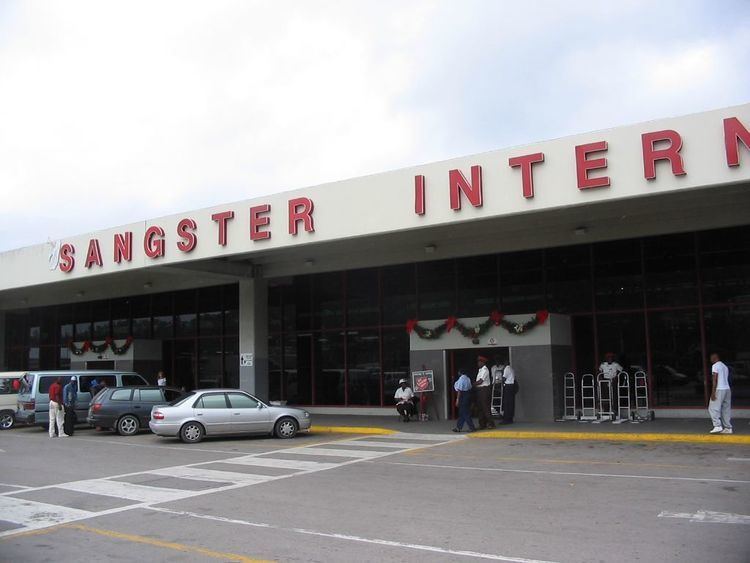Airport type Public Website mbjairport.com Elevation 1 m | Operator MBJ Airports Ltd. Elevation AMSL 4 ft / 1 m 07/25 2,653 Code MBJ Phone +1 876-952-3124 | |
 | ||
Profiles | ||
Landing at sangster international airport mbj nov 25 2016
Sangster International Airport (IATA: MBJ, ICAO: MKJS) is an international airport located 3 mi (4.8 km) east of Montego Bay, Jamaica. The airport is capable of handling nine million passengers per year. It serves as the most popular airport for tourists visiting the north coast of Jamaica. The airport is named after former Jamaican Prime Minister Sir Donald Sangster.
Contents
- Landing at sangster international airport mbj nov 25 2016
- sangster international airport montego bay
- History
- Passenger
- Charter
- Accidents and incidents
- References
Sangster is run by a consortium called MBJ Airports Limited. Leading partner of the consortium is Abertis. Another partner is Vancouver Airport Services (2% stake) Sangster was privatised and turned over by Airports Authority of Jamaica to the consortium in 2003.
sangster international airport montego bay
History
Sangster International Airport in Montego Bay, St. James, was first conceived in 1936 when the site now housing the Sangster International Airport was identified as one suitable for the construction of an airport in the town of Montego Bay. Originally named the Montego Bay Airport, a decision was made to build the runway in 1940, and the actual construction of the facility was completed on 18 February 1947. At the time of its completion, the town of Montego Bay was more like a playground for the rich and famous, and was considered then, one of the premier vacation spots within the Caribbean, just as it is today.
The first international airline to fly into the Montego Bay Airport was Pan American Airways (which eventually became Pan Am), and the airport, which in comparison to today's standards, was more like a small aerodrome, was operated by Pan American until 30 September 1949, when the Jamaican government took control of the facility. However, the Sangster International Airport, as known today, is nothing like it was in the early days. One of the most noticeable differences was that initially, the terminal building was on the northern side of the runway but was shifted to the southern side of the runway during one of the several upgrading exercises that took place at that facility, which was necessitated by the growth in air traffic over the years. Plans for the construction of a new terminal at its present location, on the southern side of the runway, were announced in July 1955. the plans for the new terminal building was part of what turned out to be a continued upgrading and restructuring of the facility, to enable it to cope with the growth in traffic. The original terminal was built and opened on 7 July 1959, with a capacity to accommodate 500 passengers per hour, and parking for seven aircraft at a time.
Over the years, the upgrading process was a continuous one, ultimately the facility had grown into the larger of the two international airports in Jamaica, handling approximately 3.7 million passengers per annum in 2007, and had seen an increase in passenger and aircraft movement in 2009. The management and partners of the airport have been trying to seek with passengers from Asia, but the project stalled in 2010. The airport is also trying receive more non-stop service from Brazil, but it has also been stopped, this time in 2013.
Since January 2001, plans have been executed to expand the airport to the status of a world-class airport. The new eastern concourse of the Sangster International Airport (SIA) (the result of phases 1A and 1B) was officially opened in December 2005. Phase two was then due to begin towards the end of 2006; however because the economic conditions were favourable and the tourist trade in Jamaica is increasing, phase two was brought forward to January 2006. MBJ still faces some challenges such as the restructuring of Air Jamaica.
A planned expansion of the main runway was in a preparation phase but due to the poor economic conditions,the runway expansion project was stopped in 2012 indefinitely. This expansion would have afforded the airport a fully functioning 10,000-foot (3,000 m) runway to accommodate large aircraft traffic. MBJ Airports Limited also commissioned a new customs hall, arrivals lobby and transportation center in March 2007. Since then, further expansion and renovation projects such as the relocation of the immigrations hall and duty-free mall have been launched and was completed in September 2008. this facility has increased the handling capacity to nine million passengers per annum. Plans are also in place for the relocation of the tower, domestic terminal and others.
In 2006, there was a change in management at the airport following the change in the consortium that operates this facility. Relations between the new management and unions have been difficult, with a strike in November 2007 and in November 2009.
The airport won the World Travel Awards "Caribbean's Leading Airport" for the years 2005, and 2009 to 2015.
Passenger
The Sangster International Airport has two terminals. One is for international flights (F) and the other for domestic travel (C). The terminals currently serve the following airlines:
Charter
^1 White Airways flights from Lisbon to Montego Bay make a stop at Samaná. However, the airline does not have rights to carry passengers solely between Montego Bay and Samaná.
